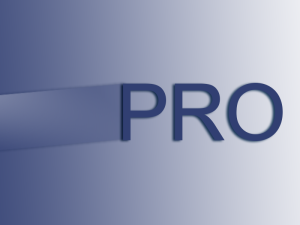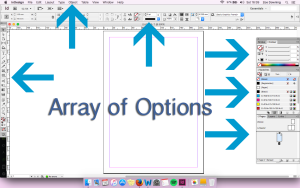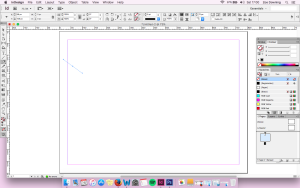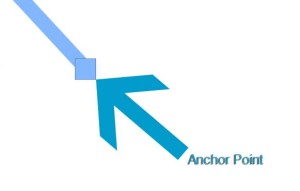Adobe programs, InDesign in particular, are primarily designed for graphic designers, photographers and artists.
However, taking up a course and utilising this wonderful program within your business yields many benefits, and you don’t even have to be an Adobe hotshot to do it.
Want to stand out from the crowd? Then InDesign is right for you. Not only can you produce and make magazines, books, eBooks etc., you can also create great business cards and other super-slick promotional materials to supercharge your business presence, too.
InDesign helps give that employee handbook you’re working on a spark of professionalism. It gives your printed and digital newsletters an edge that’s a cut above the rest. It raises up the optical appeal of what would otherwise be a pretty plain and safe whitepaper, to the visual glories of an infographic.
I won’t beat around the bush here – learning InDesign takes time, patience and dedication, especially if you’re starting out from scratch, yet these 5 useful tips will give you the knowledge and the confidence to start playing around with the program, and have been selected to form just a snippet of how using InDesign can improve your business. Check out our InDesign courses if you want more.
Professional
Steer away from Paint or Word for your business cards, and start learning InDesign. The difference in results will be obvious, even to the untrained eye i.e. clients.
With InDesign you can create contracts invoices, quotes, service guides, product catalogues, media kits, sponsorship/advertiser info, style guides, launch promotions, calendars and portfolios. And let’s not forget interactive PDFs and eBooks for your customers and employees.
eBooks and interactive PDFs have a big part to play in terms of marketing. However, don’t just think of an eBook as a 70-page long document – they can be relatively small in their size, and if you can not only write them yourself but format and publish them as well, then you will save seriously on the costs.
InDesign is not only a program dedicated to long text documents, mind you – it also holds an array of tools to help aid your visual and graphic creative processes.
That 10-year-old work-flow poster that was created in Publisher? Replace it immediately with an up-to-date brand spanking new one, complete with all the bells and whistles so your employees won’t be able to take their eyes off it
Indeed, using InDesign for even the simplest of documents will give them that cutting edge, and sail you high above the crowd.
Array of Options
InDesign plays host to a range of useful shortcuts and tools.
The shape tool, for instance, allows you to drag out a shape, rather than having to hand-draw it yourself. You can then fill the shape with any colour in any shade of your choice, and add things like shadows to give the appearance that it’s floating above the page.
Experiment with opacity found at the top menu bar, this allows the creation of shapes to be layered behind the text.
There are also many different typography options, such as shadowing and bevelling, embossing and so on. These options can make your design look top quality, easy to read and pleasing to the eye.
By using the pen tool, you can create some weird and wonderful shapes that will sit in the background of your document, giving it a clean and professional look.
Pen Tool
The pen tool spreads wide across the Adobe suite – so if you can learn it one program, you essentially have learnt it for them all. This is just as well, for mastering the pen tool takes a lot of practice – but, you’ll be thankful that you put in the effort, for once you’ve acquired the skills, you’ll be creating some amazing graphic styles and shapes that can be used on your document.
Once you create a shape with the pen tool, you can grab what are called the anchor points with the direct selection tool (found in the top left hand corner of the tools palette) and move them about. This will distort the shape to the desired form you want (with a little practice), and you can also use the same technique on any handles that denote the curvature of the shape.
You could even be extra creative and create vector graphics for your posters/leaflets/brochures etc. using the pen tool in Illustrator, and loading them across to InDesign. InDesign is capable of handling Photoshop and Illustrator formats, therefore making it hassle free.
Multiple and Master Pages
Arguably one of the best tools in InDesign. Using a master page allows you to keep the same format, colours and font on all of your pages the same. This is extremely handy when creating large documents such as magazines, whitepapers or eBooks.
Brand consistency is a very important part of your business. With this in mind, you can also create templates to load into your new documents, ensuring consistency with everything you create.
See and switch all of your pages in the pages palette. This makes for easy browsing when working on a fifty-word document.
Bounding Boxes
Bounding boxes make it especially easy to arrange your document how you wish.
Create a bounding box simply by navigating to the right hand panel in the InDesign window. Now you can place an image into that box, move it around, rotate and flip it. This will act as an entity on its own and will not interfere with other designs on your page.
Bounding boxes also allow you to wrap the text around the image, allowing for interesting and space-saving layouts.
Taking on InDesign soaks up time and requires firm dedication, yet being skilled in this remarkable program will put you in great stead for all manner of business promotions. Self-learning while running a business may seem inconceivable. But, here at Creative Studios we have a plentiful suite of courses and options that will best suit your needs.

 Click here to see all of our Software Training Courses
Click here to see all of our Software Training Courses




